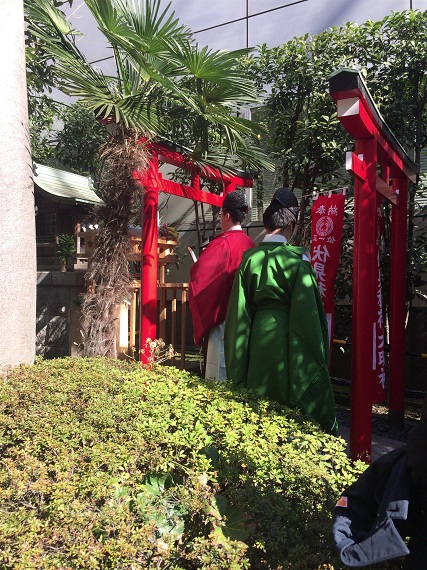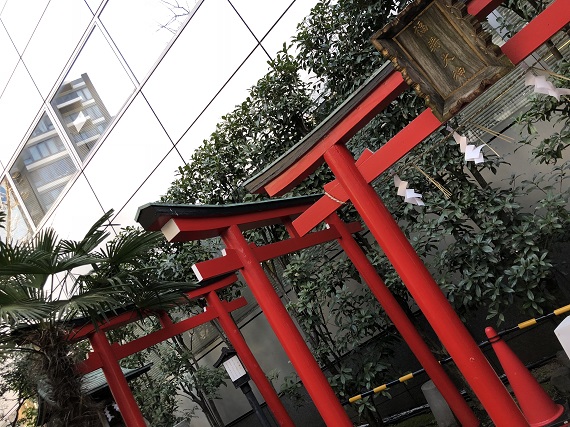
First Time in Japan
Tori-no-ichi Festival 2018
Chinese traditional holidays/festivals in Japan
稲荷祭 (Inari Festival)
In search for a new domicile: being a good neighbour in Japan
In search for a new domicile: getting a house
年賀状 (New Year’s cards)
正月飾り (New Years decorations)
Christmas in Japan
In search for a new domicile: getting an apartment
稲荷祭 (Inari Festival)
先日、稲荷祭に参加してきました。
稲荷祭は、弊社が入っているオフィスビルの一階で、年に一度行われています。
この一帯の氏神様(うじがみさま)である日枝神社(ここは首相官邸の隣にある有名な神社です)より神主様がお二人いらして、神事を執り行ってくださいました。
でも、何故にオフィスビルで稲荷祭??と思いますよね。
The Inari Festival was held the other day.
The Inari Festival is held every year on the first floor of the office building that e-Jan resides in.
Two Shinto priests from Hie Shrine (a famous shrine next to the prime minister's official residence) for this region’s ushigami-sama(*1) came to perform Shinto rituals.
But you might wonder, why would Shinto priests come to an office for an Inari Festival??
実は、ビルの正面エントランス横には、鳥居があるのです。
高いビルに囲まれた住宅街、ビル壁面のグレー色や、連なる生け垣の緑に囲まれ、小ぶりながらも朱色に塗られた鳥居は、抜群の存在感を放っています。
Actually, to the left of the building’s front entrance is a torii gate (Shinto shrine gate).
Surrounded by tall residential buildings with industrial-gray walls and nestled among sections of green hedge, the small torii with its bright, vermillion paint emanates a distinguished presence.

初出社の時に目に留まり、珍しいなぁと思いながらも、早い時間に着いてしまったので、お参りをしてからオフィスフロアに向かったりしました。
鳥居の前には、管理会社の方や、他テナントの従業員さん、ビル清掃の方々がいらして、11時ピッタリに始まりました。神主様がお祓(はら)いや、祝詞をあげられた後、私たち参拝者全員が玉串(榊の葉)を神前に捧げ、お参りをしました。
When I saw it on my first day, I recall noticing it, and stopping by to pay respects since I had a bit of time.
On the day of the Inari Festival, members of management, other building tenants, and building sanitation staff were gathered when the festival started at 11 AM.
After the priests had performed the rites for purification and blessing, us onlookers offered a branch of tamagushi (*3) to the shrine and paid our respects.
最後に、神主様から滞りなく神事が済んだ事を告げられ、振舞って頂いたお神酒を頂いて終了となりました。
帰りがけに管理会社の方から「おいなりさん」が6個入ったお土産を頂きました。きっと直会(なおらい)の代わりですね。
Finally, the priests reported that all rituals had been completed smoothly, and they provided some sacred sake for us to partake in to close the festival.
On the way back I received a gift of six ‘inari sushi’ from a member of the management, likely in place of a naorai (*5).
その際にたまたまですが、オフィスビルと稲荷祭の関係を聞く事が出来ました。
私たちのオフィスが入っているビルの敷地は、もともとは個人の持ち物だったそうです。
その方が金物屋を営んでいたそうで、商売繫盛を祈念して個人で建てたのが現在の鳥居だったそうです。
By chance, I was also able to hear the history of this inari shrine at this office building.
The plot of land that this building was originally a hardware dealer’s private property. This hardware dealer apparently built this torii for business prosperity.
広い敷地が個人の持ち物であったことや、鳥居を個人で建てることができるのにも驚きました。しかしそれ以上にかねてからの疑問が解決してスッキリしました。
鳥居だけでなく、裏手の出入り口付近にある大きな石灯籠も、どんなデザイン意図で置かれているのかしら?とずっと不思議に思っていました。
I was surprised to hear that this large plot of land used to a person’s private property, as well as that a person can build their own torii shrine. But knowing the answers to the ongoing mysteries was exciting.
This made me wonder about the large stone lantern at the back entrance of the building; was it placed there on purpose? Was it designed that way for a reason? Another mystery arises.
雲一つない青空の下でお参りできて、清々しい気持ちに。
そして、今働いている場所の昔の姿を少しだけ伺い知れて、とても貴重な経験をさせてもらえました。
これからは、もっと頻繁にお参りをしようと思いました!
Giving prayer under a cloudless blue sky provided me with a moment of serenity.
Most of all, being able to learn the history of the place where I work and see a glimpse of the past was a truly valuable experience.
I think I’ll visit the shrine more often from now on!

Guest contributor: M.S.
English translation: N.M.
=====================
※1氏神様(うじがみさま)
同じ地域に住む人達が共通で祀る神様のこと
Ushigami-sama: the patron god of a region
※2祝詞(のりと)
神に祈る時に神主様が言う文章。
Norito: prayers said by a Shinto priest
※3玉串(たまぐし)
神前のお参りに捧げるもの。常緑樹の榊を使うことが多く、青々としている榊は、生命力や繁栄の象徴とされている。
Tamagushi: branch of a sacred tree that is offered to a shrine. Evergreen tree branches are most common as their deep green color symbolises vitality and prosperity.
※4お神酒(おみき)
神前に供えるお酒のこと。神事の終了直後に飲む風習がある。
これはお酒に宿った霊力を体の中に入れるという意味がある。
Omiki: Sacred sake/wine offered to a shrine. Traditionally drunk after Shinto rituals to symbolise ‘taking in’ the spiritual power present in the liquor.
※5直会(なおらい)
神社にお参りをした後で、食事やお茶をして帰ること。
もとは、神様にお供えしたものを食べて、体内に「福」を取り入れる風習だった。
Naorai: The practice of enjoying food and drink after a shrine visitation. This stems from the tradition of eating the food that was offered in order to taken in the fortune imbued in the food.
稲荷祭は、弊社が入っているオフィスビルの一階で、年に一度行われています。
この一帯の氏神様(うじがみさま)である日枝神社(ここは首相官邸の隣にある有名な神社です)より神主様がお二人いらして、神事を執り行ってくださいました。
でも、何故にオフィスビルで稲荷祭??と思いますよね。
The Inari Festival was held the other day.
The Inari Festival is held every year on the first floor of the office building that e-Jan resides in.
Two Shinto priests from Hie Shrine (a famous shrine next to the prime minister's official residence) for this region’s ushigami-sama(*1) came to perform Shinto rituals.
But you might wonder, why would Shinto priests come to an office for an Inari Festival??
実は、ビルの正面エントランス横には、鳥居があるのです。
高いビルに囲まれた住宅街、ビル壁面のグレー色や、連なる生け垣の緑に囲まれ、小ぶりながらも朱色に塗られた鳥居は、抜群の存在感を放っています。
Actually, to the left of the building’s front entrance is a torii gate (Shinto shrine gate).
Surrounded by tall residential buildings with industrial-gray walls and nestled among sections of green hedge, the small torii with its bright, vermillion paint emanates a distinguished presence.

初出社の時に目に留まり、珍しいなぁと思いながらも、早い時間に着いてしまったので、お参りをしてからオフィスフロアに向かったりしました。
鳥居の前には、管理会社の方や、他テナントの従業員さん、ビル清掃の方々がいらして、11時ピッタリに始まりました。神主様がお祓(はら)いや、祝詞をあげられた後、私たち参拝者全員が玉串(榊の葉)を神前に捧げ、お参りをしました。
When I saw it on my first day, I recall noticing it, and stopping by to pay respects since I had a bit of time.
On the day of the Inari Festival, members of management, other building tenants, and building sanitation staff were gathered when the festival started at 11 AM.
After the priests had performed the rites for purification and blessing, us onlookers offered a branch of tamagushi (*3) to the shrine and paid our respects.
最後に、神主様から滞りなく神事が済んだ事を告げられ、振舞って頂いたお神酒を頂いて終了となりました。
帰りがけに管理会社の方から「おいなりさん」が6個入ったお土産を頂きました。きっと直会(なおらい)の代わりですね。
Finally, the priests reported that all rituals had been completed smoothly, and they provided some sacred sake for us to partake in to close the festival.
On the way back I received a gift of six ‘inari sushi’ from a member of the management, likely in place of a naorai (*5).
その際にたまたまですが、オフィスビルと稲荷祭の関係を聞く事が出来ました。
私たちのオフィスが入っているビルの敷地は、もともとは個人の持ち物だったそうです。
その方が金物屋を営んでいたそうで、商売繫盛を祈念して個人で建てたのが現在の鳥居だったそうです。
By chance, I was also able to hear the history of this inari shrine at this office building.
The plot of land that this building was originally a hardware dealer’s private property. This hardware dealer apparently built this torii for business prosperity.
広い敷地が個人の持ち物であったことや、鳥居を個人で建てることができるのにも驚きました。しかしそれ以上にかねてからの疑問が解決してスッキリしました。
鳥居だけでなく、裏手の出入り口付近にある大きな石灯籠も、どんなデザイン意図で置かれているのかしら?とずっと不思議に思っていました。
I was surprised to hear that this large plot of land used to a person’s private property, as well as that a person can build their own torii shrine. But knowing the answers to the ongoing mysteries was exciting.
This made me wonder about the large stone lantern at the back entrance of the building; was it placed there on purpose? Was it designed that way for a reason? Another mystery arises.
雲一つない青空の下でお参りできて、清々しい気持ちに。
そして、今働いている場所の昔の姿を少しだけ伺い知れて、とても貴重な経験をさせてもらえました。
これからは、もっと頻繁にお参りをしようと思いました!
Giving prayer under a cloudless blue sky provided me with a moment of serenity.
Most of all, being able to learn the history of the place where I work and see a glimpse of the past was a truly valuable experience.
I think I’ll visit the shrine more often from now on!

Guest contributor: M.S.
English translation: N.M.
=====================
※1氏神様(うじがみさま)
同じ地域に住む人達が共通で祀る神様のこと
Ushigami-sama: the patron god of a region
※2祝詞(のりと)
神に祈る時に神主様が言う文章。
Norito: prayers said by a Shinto priest
※3玉串(たまぐし)
神前のお参りに捧げるもの。常緑樹の榊を使うことが多く、青々としている榊は、生命力や繁栄の象徴とされている。
Tamagushi: branch of a sacred tree that is offered to a shrine. Evergreen tree branches are most common as their deep green color symbolises vitality and prosperity.
※4お神酒(おみき)
神前に供えるお酒のこと。神事の終了直後に飲む風習がある。
これはお酒に宿った霊力を体の中に入れるという意味がある。
Omiki: Sacred sake/wine offered to a shrine. Traditionally drunk after Shinto rituals to symbolise ‘taking in’ the spiritual power present in the liquor.
※5直会(なおらい)
神社にお参りをした後で、食事やお茶をして帰ること。
もとは、神様にお供えしたものを食べて、体内に「福」を取り入れる風習だった。
Naorai: The practice of enjoying food and drink after a shrine visitation. This stems from the tradition of eating the food that was offered in order to taken in the fortune imbued in the food.










